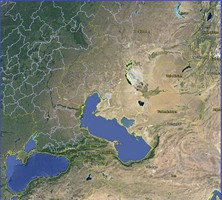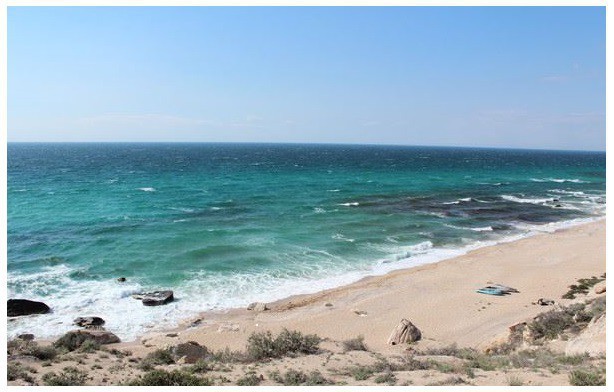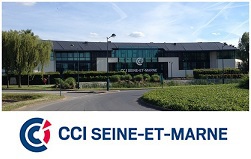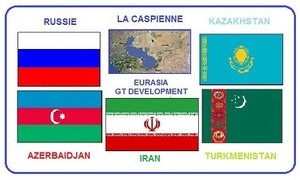
Within the framework of Eurasia GT Development the approach consists
in facilitating a movement of business between
the Seine and Marne
and the Countries bordering the Caspian Sea one :
Kazakhstan, Iran, Russia of South-west (Caucasian), Azerbaijan, Turkmenistan.
But, of course, so of opportunities present themselves, it will be the same for the Ile de France, France and States being next to it (Belgium, Luxembourg, Switzerland, Monaco and Andorre).
The five countries which borders the Caspian Sea - Russia, Azerbaijan, Iran, Turkmenistan and Kazakhstan - are separated by a maritime border.
This border, which formerly separated Europe and Asia, becomes today the hyphen between these two continents.
The evolution of the climate and the water resources is a major stake for the regional capitals: Bakou, Tehran, Astana, Astrakhan and Achgabat.
The five Caspian States will have to cooperate so that the “Caspian Sea” becomes a tourist source of wealth, economic, ecological, cultural, in a constructive and advantageous approach with all the regional powers.
Tomorrow, the availability out of water will be the problem posed with all, and the Caspian one - this huge inland sea - will have to meet these needs.
All will have to be undertaken to keep with water an acceptable purity, from where the many challenges which arise to these countries, and that they will be able to solve only together.
The Framework Convention for the Protection
of the Marine Environment of the Caspian Sea was signed
by the five Caspian littoral States
in November 2003 and entered into force on August 12th 2006.
At the 1st Meeting of the Conference of the Parties (COP1) the littoral States decided to declare the 12th of August the "Caspian Day" marking the importance of the Tehran Convention as the overarching legal instrument for environmental protection in the Caspian Sea region. By now Caspian Day is publicly celebrated annually in each Caspian country with special events at the occasion.
The Protocol Concerning Regional Preparedness, Response and Co-operation in Combating Oil Pollution Incidents
("Aktau Protocol")
|
Status |
Azerbaijan |
I.R. of Iran |
Kazakhstan |
Russian Federation |
Turkmenistan |
|---|---|---|---|---|---|
|
Signed |
12/08/2011 |
12/08/2011 |
12/08/2011 |
12/08/2011 |
03/11/2011 |
|
Ratified |
21/12/2012 |
15/08/2012 |
(p) |
25/06/2013 |
22/12/2012 |
The Protocol for the Protection of the Caspian Sea against Pollution from Land-based Sources and Activities
("Moscow Protocol")
|
Status |
Azerbaijan |
I.R. of Iran |
Kazakhstan |
Russian Federation |
Turkmenistan |
|---|---|---|---|---|---|
|
Signed |
x |
12/12/2012 |
05/05/2013 |
02/05/2013 |
12/12/2012 |
|
Ratified |
25/02/2014 (a) |
12/05/2014 |
(p) |
(p) |
23/05/2015 |
The Protocol for the Conservation of Biological Diversity
("Ashgabat Protocol")
|
Status |
Azerbaijan |
I.R. of Iran |
Kazakhstan |
Russian Federation |
Turkmenistan |
|---|---|---|---|---|---|
|
Signed |
30/05/2014 |
22/02/2015 |
30/05/2014 |
||
|
Ratified |
23/05/2015 |
Legend:
(a): accession
(p): pending
Caspian Sea Region
The Caspian Sea is the largest enclosed body of water on earth
Ecological system
The isolation of the Caspian basin for over two million years and its climatic and salinity gradients has created a unique ecological system with more than 400 species endemic to the Caspian Sea.
There are 115 species of fish, of which some are anadromous migrating from the Caspian up the rivers to spawn. The Caspian sturgeon and the rare fresh water seal are among the most famous species indigenous to the Caspian.
In fact, more than 90 % of the world resources of sturgeon originate from the Caspian Sea. The vast river system and extensive wetlands attract millions of migrating birds and are the habitat of diverse flora and fauna.
Natural Resources and main threats
The Caspian basin is rich in commercially developable hydrocarbon deposits. But the increasing number of oil and gas producing industries as well as hydrocarbon productions and exports constitute serious environmental threats.
Years of intensive oil production and refining at industrial sites has polluted ground water, led to widespread oil-mingled soil and the discharge of toxic drilling mud into the Caspian Sea.
Moreover, the large rivers polluted with industrial wastes, heavy metals and sewage flowing into the Caspian Sea contribute to the impairment of the habitat of so many species.
The mass mortality of more than 3 000 Caspian seals and various species of fish in 2000 was caused by a high amount of toxic substances discovered in the carcass.
Today, Caspian biota is threatened by over-exploitation, habitat destruction and pollution.
The traditional Caspian sturgeon fishery is well-known for its caviar production. In recent years, however, the Caspian region has witnessed a serious decline in fish stocks. More efficient fishing methods combined with over-fishing and extensive poaching, dam constructions, introduction of invasive species as well as increased pollution are relevant factors contributing to the dramatic decline.
Division
The Caspian Sea is commonly divided into three parts, the North, Middle and South Caspian Sea.
The border between the northern and middle part runs along the edge of the North Caspian shelf (the Mangyshlak threshold), between Chechen Island and Cape Tiub-Karagan at Fort Shevchenko.
The border between the middle and southern part runs from the Apsheron threshold connecting Zhiloi Island in the west to Cape Kuuli in the east. While the North Caspian Sea with an average depth of only 6.2 m is rather shallow, the middle part has an average depth of 190 m and the South Caspian Sea reaches a maximum depth of 1 025 m.
Climate
The Caspian differs from most other large inland water bodies in its meridian orientation and 1 200 km length resulting in extreme continental climate in the North and sub-tropical climate in the South.
The range of climatic conditions that prevail around the Caspian Sea has lead to a significant degree of biological diversity.
This is further enhanced by the existence of extensive wetland systems such as the deltas of the Volga, Ural and Kura rivers and the Kara-Bogaz-Gol.
Facts
Surface area - 436 000 km²
Tributaries – around 130 rivers, The main rivers are Volga (241 km³), Kura (13 km³), Terek (8.5 km³), Ural (8.1 km³) and Sulak (4 km³) contributing to over 90% of the Caspian’s freshwater inflow
The Caspian Sea is an endorheic basin (it has no outlet to the world oceans).
Level of the sea – 27 meters below MSL
Littoral countries - Azerbaijan, I.R. of Iran, Kazakhstan, Russian Federation and Turkmenistan










